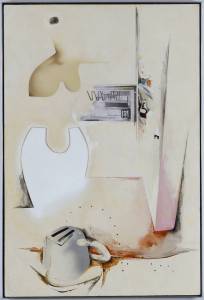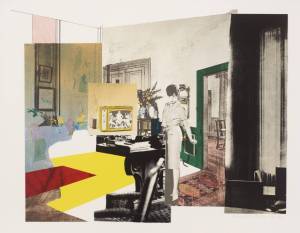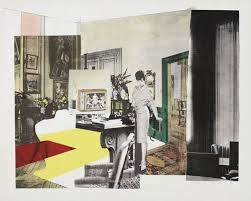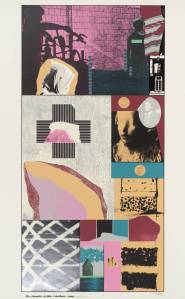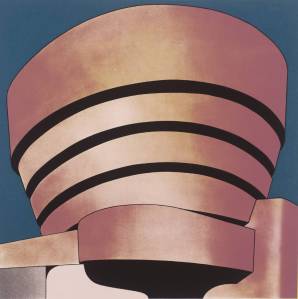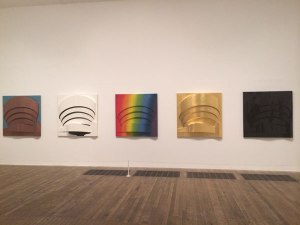Richard Hamilton’s painting featured incomplete, fragmented images from as early as the mid-Fifties, $he, for example, 1958:
By the mid-Sixties, Hamilton optimised his exploration of this approach through the use of the screenprint medium. As in, Interior, 1965, below, Hamilton tended to create a ‘snapshot’ of a supposed ‘real’ scene using generic visual componentry which would not usually be consistent in terms of size, style, perspective, etc:
This print is # 410 in the Editions Alecto catalogue, issued in an edition of 50. Prior to the final print run, 4 proofs were pulled which have a rather more cluttered background:
In contrast, Kitaj – like Paolozzi – favoured the juxtaposition of apparently unrelated images as a stimulus to creative thinking on the part of the viewer, as here for example in, The Republic of the Southern Cross, 1964, from the Mahler Suite:
In the Catalogue Raisonne of Kitaj’s prints by Jennifer Ramkalawon, ISBN 978-0-7141-2685-2, this print is annotated:
In Kitaj’s 1965 New York catalogue, he stated that this print was ‘closely associated with the 1st movement of the 9th symphony which Berg called “the most heavenly thing Mahler ever wrote”’. He also mentions that he borrowed from magazine reproductions of work by ‘M Rosso, B Fuller and F Stella’. Clearly discerned in the print are a sculpture by Medardo Rosso (Ecce Puer ou Impression d’enfant; portrait d’Alfred Mond a lage de six ans, 1906) and a ‘Cross’ painting by Frank Stella; the lattice patterns lower left recall Buckminster Fuller’s geodesic domes. The latter replaced an image of a maquette for Matisse’s sculpture La Serpentine (1909).
Just while on the subject of the Southern Cross, in paintings I completed in 2009, works complied with the series name ‘Perfect Symmetry’ by their title if not their visual componentry. Thus, Discovery of St Helena, (below), refers to two symmetrical ‘facts’: the first accurate observations of the Southern Cross were made by Edmund Halley from the island of St Helena in 1676/Saint Helena herself is said to have discovered the original Cross in the hill at Golgotha 300 years after the Crucifixion.
Now, back to Richard Hamilton. The screenprint he made of the Guggenheim Museum façade in 1965, ea 411, was the forerunner for a series of reliefs of the image created the following year. The print, (edition of 50):
And the reliefs, (fibreglass and cellulose):
Three multiple versions were published in Switzerland in an edition of 750 in 1970.
A great image, great artist and a great building.
